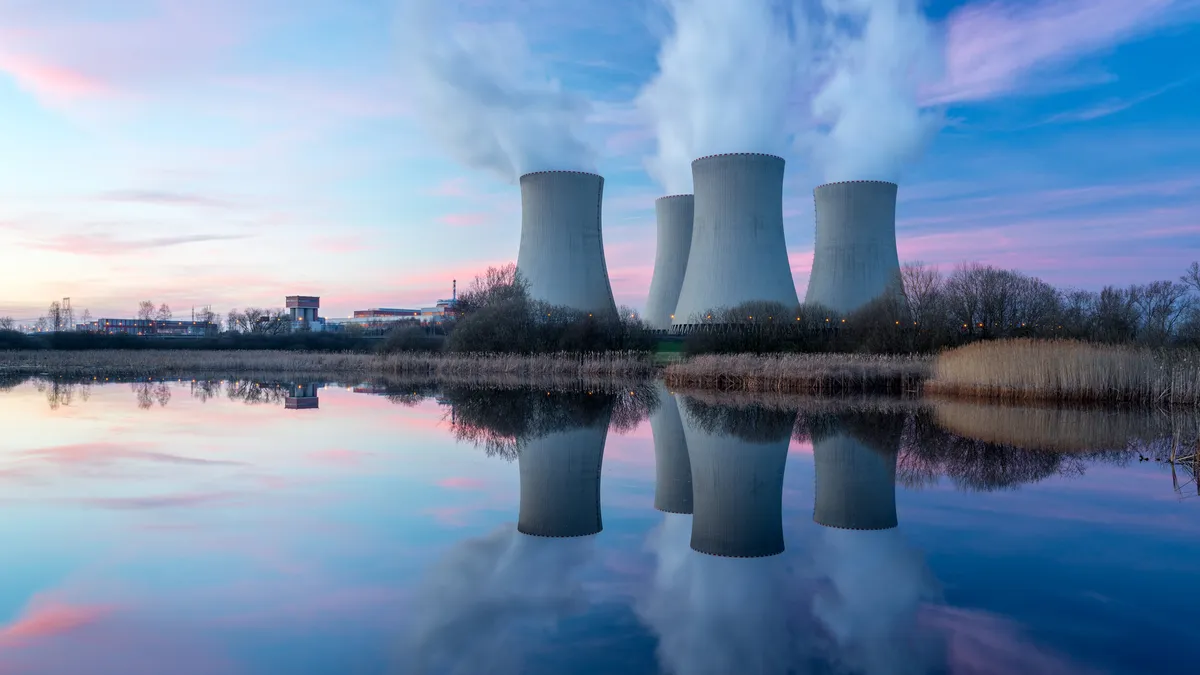Dive Brief:
- The sites of operating or recently retired U.S. nuclear power plants could support up to 95 GW of additional electric power production capacity from newly-built nuclear reactors, the Department of Energy said in a Sept. 3 report.
- Forty-one reactor sites could host up to 60 GW of new capacity from large light-water reactors, such as the AP-1000, or up to 95 GW of new capacity from smaller 600-MWe advanced reactors, DOE said.
- Companies previously engaged with the Nuclear Regulatory Commission to obtain combined construction and operating licenses to construct 17 new reactors at 12 of the 41 suitable sites, which could have resulted in a total of 24 GW of new nuclear reactor capacity, DOE said in the report. While those reactors were never built, “there is a very high degree of confidence that these sites would be potentially suitable to host a reactor,” DOE said.
Dive Insight:
The DOE report, “Evaluation of Nuclear Power Plant and Coal Power Plant Sites for New Nuclear Capacity,” also examined operating or recently-retired U.S. coal power plants for new nuclear potential.
The 145 coal sites the report examined could host 128 GW to 174 GW of nuclear electric-generating capacity, depending on the size of the reactors used in repowering, DOE said. Thirty-six states have potentially suitable coal sites and 31 states have potentially suitable nuclear sites.
All told, the nuclear and coal power plant sites DOE’s report examined could host up to 269 GW of new nuclear generation capacity using 600-MWe reactors, significantly more than the approximately 200 GW of advanced reactor capacity envisioned by 2050 in DOE’s 2022 advanced nuclear liftoff report.
A separate DOE report released in 2022 found that about 80% of operating or recently-retired U.S. coal power plants could host up to 265 GW of advanced nuclear reactor capacity. Transitioning an existing coal power plant site to host advanced nuclear could create 30 to 100 new jobs, depending on generating capacity, DOE said in April.
The Sept. 3 report evaluated sites’ footprint and acreage, utility plans and factors such as cooling water availability, proximity to population centers or hazardous facilities, and flood and seismic risk to determine suitability for new nuclear reactors, DOE said. The initial analysis covered all 54 operational and 11 recently retired U.S. nuclear sites.
DOE considered the potential for new 600-MWe, 1,000-MWe and 1,117-MWe reactors on coal power plant sites, and 600-MWe and 1,117-MWe reactors on nuclear power plant sites. The Westinghouse AP-1000 pressurized water reactor, the design used in Plant Vogtle Units 3 and 4, has a nominal electric generating capacity of 1,110 MW.
Among partially or fully operational coal power plants set to retire by 2040, DOE found 33 sites in 18 states potentially suitable for nuclear conversions. A total of 72 advanced reactors, 37 light-water reactors rated at 1,000 MWe or 31 light-water reactors rated at 1,117-MWe could repower these sites, DOE found.
DOE also identified 27 recently retired coal sites in 16 states that could be repowered with a total of 45 advanced reactors, 15 large light-water reactors or 12 larger light-water reactors.
The biggest group of potential coal-to-nuclear sites — 85 sites in 28 states — have not yet reported retirement dates to the U.S. Energy Information Administration and are thus assumed to continue operating past 2040, DOE said. Those sites could host up to 173 advanced reactors, 84 large light-water reactors or 72 larger light-water reactors, according to the report.
In its analysis of existing U.S. nuclear power plant sites, DOE identified a total of 20 potentially suitable sites that had canceled plans for additional reactor capacity or that actually sought NRC licensing for new reactors. Based on the utilities’ original plans, these sites could host 31 larger light-water reactors with 37.9 GWe of total generating capacity, while 18 of the 20 sites would be suitable to host 72 smaller advanced reactors with 43.2 GWe of total generating capacity, DOE said.
Of the remaining 34 sites, 17 were potentially suitable to host one or two additional larger light-water reactors with cumulative generating capacity of 21.2 GWe, and 23 were potentially suitable to host up to 79 smaller advanced reactors with total generating capacity of 47.4 GWe, DOE said.
Most of the latent capacity is found at currently operating nuclear sites, according to the report. But seven states — Nebraska, Iowa, Wisconsin, Michigan, New Jersey, Massachusetts and Vermont — have retired nuclear power plants that could be suitable for repowering, DOE said














